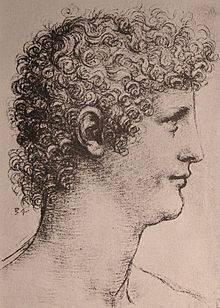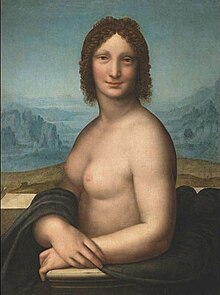art.wikisort.org - Artist
Gian Giacomo Caprotti da Oreno, better known as Salaì[lower-alpha 1] (1480 – January 19, 1524) was an Italian artist and pupil of Leonardo da Vinci from 1490 to 1518. Salaì entered Leonardo's household at the age of ten. He created paintings under the name of Andrea Salaì. He was described as one of Leonardo's students and lifelong companion and servant and was the model for Leonardo's St. John the Baptist, Bacchus and Angelo incarnato.[1]
Salaì | |
|---|---|
 Drawing thought to be Salaì by Leonardo da Vinci | |
| Born | Gian Giacomo Caprotti da Oreno 1480 Oreno, Vimercate, Italy |
| Died | January 19, 1524 (aged 43–44) Milan, Italy |
| Nationality | Italian |
| Notable work | Monna Vanna, Penitent Magdalene |
| Movement | High Renaissance |
| Spouse | Bianca Coldirodi d'Annono
(m. 1523) |
| Patron(s) | Leonardo da Vinci |
Early life

Salaì was born in 1480 as son of Pietro di Giovanni, a tenant of Leonardo's vineyard near the Porta Vercellina, Milan.[2]
He joined Leonardo's household at the age of ten as an assistant. Giorgio Vasari describes Salaì as "a graceful and beautiful youth with curly hair, in which Leonardo greatly delighted".[2] Although Leonardo described him as "a liar, a thief, stubborn, and a glutton" and he stole from Leonardo on at least five occasions, he kept Salaì in his household for more than 25 years, in which Salaì trained as an artist.[2] Salaì became a capable, although not very impressive, painter,[3] who created several works, including the Monna Vanna, a nude version of the Mona Lisa which may be based on a charcoal sketch by Leonardo.[4][5] He is also considered one potential creator of the Prado's copy of the Mona Lisa.[6]
Leonardo is thought to have used Salaì as the model for several of his works, specifically St. John the Baptist, Bacchus and Angelo Incarnato.[1][6] Some researchers also believe that Salaì – and not Lisa del Giocondo – was the real model for the Mona Lisa, but this claim is disputed by the Louvre.[6]

During Leonardo's second stay in Milan, he took another young pupil, Francesco Melzi. Unlike Salaì, Francesco was a son of a nobleman. When Leonardo traveled to Rome in 1513 and to France in 1516, Salaì and Melzi both accompanied him. As an adult, Melzi became secretary and main assistant of Leonardo, and undertook to prepare Leonardo's writings for publication. Vasari wrote that Melzi "at the time of Leonardo was a very beautiful and very much loved young man".[citation needed] In France, Francesco Melzi was greeted as "Italian gentleman living with master Leonardo" and granted donation of 400 ecus, while Salaì, 36 years old, was described as "servant" and granted a one time donation of 100 ecus.[citation needed]
Salaì left France, and Leonardo, in 1518. He later returned to Milan to work on Leonardo's vineyard, previously worked by Salaì's father, half of which was granted to him in Leonardo's will.[7] It is commonly believed that upon Leonardo's death in 1519, Salaì inherited several paintings including the Mona Lisa. Through his estate, many of those works, notably the Mona Lisa, passed into the possession of Francis I of France.[8] While Leonardo left all personal belongings, paintings, drawings and notes to Francesco Melzi in his will, it is unclear whether this included the Mona Lisa.[9]
On 14 June 1523, at age 43, Salaì married Bianca Coldirodi d'Annono.[10] Salaì died in 1524 as a result of a wound received from a crossbow in a duel[11] and was buried in Milan on 10 March 1524.[12]
Salaì's sexuality
![Angelo Incarnato, drawing of Salaì by Leonardo, c. 1515[1]](http://upload.wikimedia.org/wikipedia/commons/thumb/b/b0/Leonardo_da_Vinci_-_Angelo_Incarnato.jpg/170px-Leonardo_da_Vinci_-_Angelo_Incarnato.jpg)
A number of drawings among the works of Leonardo and his pupils make reference to Salaì's sexuality. There is a drawing modelled on Leonardo's painting John the Baptist and called The Angel Incarnate (Angelo incarnato), of a young man nude with an erect phallus, and representing Salaì.[1] It is accepted as by Leonardo's hand.[13] The face of the figure is closer to Salaì's copy of Leonardo's painting John the Baptist, than to the original in the Louvre.
Leonardo‘s folio Codex Atlanticus includes two pages (132 and 133, verso) of drawings by a hand other than Leonardo's, one of which is a crudely drawn sketch depicting an anus, identified as "Salaì's bum", pursued by penises on legs.[14][15][2]
Relationship to the Mona Lisa
A group of Italian researchers has claimed that Salaì was the model for the Mona Lisa, noting the similarity in some of the facial features, particularly the nose and mouth, to those in which Salaì is thought to have been the model. These claims have been disputed by the Louvre.[16]
In popular culture
Films
Films or TV Series which are about the life of Leonardo or in which he appears as a character:
- The Life of Leonardo da Vinci (1972) interpreted by Bruno Piergentili
- Leonardo (2021) interpreted by Carlos Cuevas
Others
- Salaì is a principal character in the novel Cenacolo[17] by Joseph Orbi.
- In Paul McAuley's 1994 novel Pasquale's Angel set in an alternate Italian Renaissance, Salaì is the main antagonist.
- DC Comics' 1995 Vertigo series Chiaroscuro: The Private Lives of Leonardo da Vinci (later published as a graphic novel) tells a speculative story of a love affair between Leonardo and Salaì.
- In a DLC of the 2010 video game Assassin's Creed: Brotherhood, Ezio (protagonist) interacts with Salaì when searching for Leonardo da Vinci. The game portrays Salaì as Leonardo's lover, and that Ezio is aware of the relationship. He is supportive of it, telling Leonardo that he approves of his relationship.
- Giacomo is the main character in the novel Leonardo's Shadow by Christopher Grey[18]
- Salaì is the main character in the 1975 children's historical fiction novel The Second Mrs. Giaconda by E. L. Konigsburg.
- Salaì is a principal character with Leonardo in Mário Cláudio's 2014 Portuguese novel Retrato de Rapaz (Portrait of a Boy).
Notes
- Salaì is a contracted form of Saladino (Saladin). Leonardo da Vinci referred to Gian Giacomo by that nickname – since he was a child – as a joke, because he had a terrible temperament: As dangerous as the Saladin. As an infidel (because Saladin was not Catholic), and therefore by extension as a demon, or a "little devil".
References
- Pedretti, Carlo (2009). Leonardo da Vinci : l'Angelo incarnato & Salai = the Angel in the flesh & Salai (in English and Italian). Margherita Melani, Daniel Arasse, da Vinci Leonardo. Foligno (Perugia): Cartei & Bianchi. p. 201. ISBN 978-88-95686-11-0. OCLC 500794484.
- Stern, Keith (September 2009). Queers in History: The comprehensive encyclopedia of historical gays, lesbians, and bisexuals. BenBella Books. p. 276. ISBN 978-1-933771-87-8 – via Google Books.
- Hall, M.C. (September 2007). Leonardo da Vinci. ABDO Publishing Company. p. 53. ISBN 978-1-59928-844-4 – via Google Books.
- "Expert: Da Vinci painted nude Mona Lisa". UPI News. United Press International. 16 November 2009. Retrieved 22 March 2011.
- "'Mona Lisa nude sketch' found in France". BBC News. 28 September 2017. Retrieved 29 September 2017.
- Waters, Florence (6 March 2012). "Mona Lisa copy may have been painted by Leonardo da Vinci's lover, art historians suggest". The Daily Telegraph. Retrieved 29 September 2017.
- Rui, Andrea (7 March 2016). Santa Maria delle Grazie (PDF) (e‑book) (in Italian). p. 6. ISBN 9788892563704. Retrieved 8 October 2022 – via Libreria Universitaria (unilibro). URL access = one-time payment.
- Zöllner, Frank (May 2000). Leonardo da Vinci, 1452–1519. Taschen. p. 94. ISBN 3-8228-5979-6 – via Google Books.
- Capra, Fritjof (30 October 2007). The Science of Leonardo: Inside the mind of the great genius of the Renaissance. Knopf Doubleday Publishing Group. p. 13. ISBN 9780385524117 – via Internet Archive (archive.org).
- Farago, Claire J., ed. (1999). Leonardo's Art: Twentieth-century connoisseurship and iconographic studies. Leonardo's Projects from 1500–1519. Vol. 3. Taylor and Francis. p. 397.
- Judah, Hettie (7 November 2019). "The men who Leonardo da Vinci loved". BBC News.
- da Vinci, Leonardo (1999). Farago, Claire J. (ed.). Leonardo da Vinci, Selected Scholarship: Leonardo's projects, c. 1500–1519. Taylor & Francis. p. 397. ISBN 9780815329350 – via Google Books.
- Nicholl, Charles. (2004). Leonardo da Vinci : flights of the mind. New York, N.Y., U.S.A. :Viking Penguin, page 602
- da Vinci, Leonardo. "Codex Atlanticus". codex-atlanticus.it (in English and Italian). The Visual Agency. p. 132 verso. Retrieved 4 July 2022.
- da Vinci, Leonardo. "Codex Atlanticus". codex-atlanticus.it (in English and Italian). The Visual Agency. p. 133 verso. Retrieved 4 July 2022.
- "Mona Lisa model was male, researchers say". ABC News. 3 February 2011. Retrieved 22 March 2011.
- Orbi, Joseph (12 May 2010). Cenacolo: Novel. I.O. Twomey. ISBN 9780966161984.
- Grey, Christopher (4 March 2008). Leonardo's Shadow. ISBN 9781416905448.
External links
- Leonardo da Vinci: anatomical drawings from the Royal Library, Windsor Castle, exhibition catalog fully online as PDF from The Metropolitan Museum of Art, which contains material on Salaì (see index)
- The L(eonardo) and the S(alai)
На других языках
[de] Salaj (Maler)
Salaj (* um 1480 in Mailand; † vor dem 10. März 1524 ebenda; eigentlicher Name Gian Giacomo Caprotti) war ein italienischer Maler der lombardischen Schule aus dem direkten Umkreis des Leonardo da Vinci.- [en] Salaì
[es] Salai
Gian Giacomo Caprotti da Oreno, llamado Salai o Salaino (nacido hacia 1480 - Milán, 19 de enero de 1524[1]), fue un pintor renacentista italiano, discípulo y ayudante de Leonardo da Vinci.[fr] Salai
Gian Giacomo Caprotti ou Giacomo Caprotti da Oreno, dit Salai, Salaï, Salaij, Andrea Salai ou Salaì en italien (de Sala[d]ino : petit diable) (né à Milan vers ~1480 et mort dans sa ville natale avant le 10 mars 1524) est un peintre italien de l'école lombarde de l'entourage de Léonard de Vinci, son élève, son disciple dès ses 10 ans.[it] Gian Giacomo Caprotti
Gian Giacomo Caprotti, detto il Salaì o il Salaino (da "Sala[d]ino" ovvero "diavolo") (Oreno, 27 dicembre 1480 – Milano, 19 gennaio 1524), è stato un pittore italiano, allievo prediletto di Leonardo da Vinci. Figura emblematica, ebbe col maestro un rapporto controverso come testimonia il suo curioso soprannome, finendo per essere una delle persone a lui più vicine; c'è chi ipotizza fosse, oltre che allievo, anche amante del grande maestro. Venne spesso usato come modello, e il suo volto androgino rappresentato, si pensa, anche in soggetti femminili. Ebbe una carriera indipendente nell'ambito dei cosiddetti leonardeschi.[ru] Салаи
Салаи (Салаино; итал. Salaì, Il Salaìno — «дьяволёнок»[1]; 1480 — 19 января 1524), настоящее имя Джан Джакомо Капротти да Орено (итал. Gian Giacomo Caprotti da Oreno) — ученик Леонардо да Винчи, второй из двух юношей, помимо Франческо Мельци, с которым художника связывали длительные — более 25 лет — и, возможно, интимные отношения[2].Другой контент может иметь иную лицензию. Перед использованием материалов сайта WikiSort.org внимательно изучите правила лицензирования конкретных элементов наполнения сайта.
WikiSort.org - проект по пересортировке и дополнению контента Википедии